The Fire Retardant Coatings Market is estimated to be valued at USD 6.1 billion in 2025 and is projected to reach USD 10.9 billion by 2035, registering a compound annual growth rate (CAGR) of 6.0% over the forecast period.
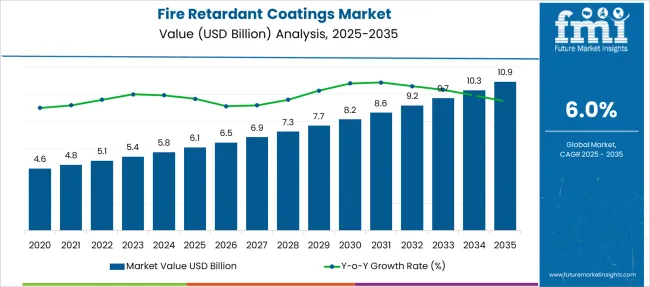
| Metric | Value |
|---|---|
| Fire Retardant Coatings Market Estimated Value in (2025 E) | USD 6.1 billion |
| Fire Retardant Coatings Market Forecast Value in (2035 F) | USD 10.9 billion |
| Forecast CAGR (2025 to 2035) | 6.0% |
The fire retardant coatings market is experiencing steady growth driven by increasing safety regulations and heightened awareness of fire prevention in various industries. Growing concerns about protecting infrastructure, vehicles, and equipment from fire damage have led to higher demand for effective coatings.
Innovations in coating formulations have improved performance characteristics, including heat resistance, durability, and environmental compliance. Demand is also being fueled by stricter fire safety codes in automotive manufacturing and construction sectors.
Additionally, the trend towards lightweight materials and eco-friendly coatings is influencing product development. The market outlook is positive as industries continue to invest in fire safety solutions and materials that meet evolving regulatory standards. Segmental growth is expected to be led by non-intumescent fire retardant coatings as the preferred product type, boron-based coatings due to their effectiveness and stability, and the automotive industry as a key end-user sector.
The market is segmented by Product Type, Material, and End-user Industry and region. By Product Type, the market is divided into Non-intumescent Fire Retardant Coatings and Intumescent Fire Coatings. In terms of Material, the market is classified into Boron-based Fire Retardant Coatings and Phosphorus-based Fire Retardant Coatings. Based on End-user Industry, the market is segmented into Automotive, Oil & Gas, Construction, Electrical & Electronics, Aerospace, Marine, Furniture, Textile, and Others. Regionally, the market is classified into North America, Latin America, Western Europe, Eastern Europe, Balkan & Baltic Countries, Russia & Belarus, Central Asia, East Asia, South Asia & Pacific, and the Middle East & Africa.
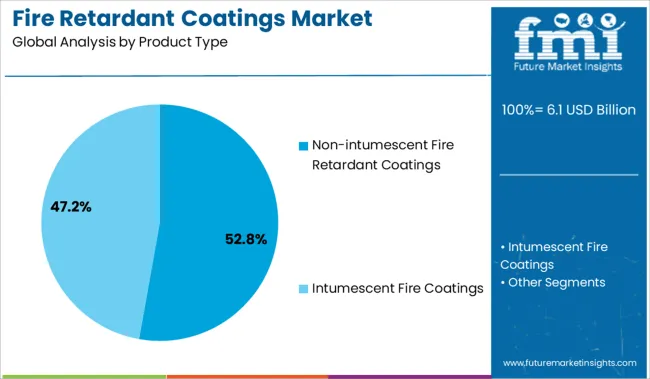
The non-intumescent fire retardant coatings segment is projected to hold 52.8% of the market revenue in 2025, maintaining its leading position among product types. This segment has grown due to the coatings’ ability to provide reliable fire resistance without the need to expand or char during exposure to heat.
These coatings are favored for applications requiring a thin and durable protective layer that does not alter the surface appearance or dimensions significantly. Their ease of application and compatibility with various substrates have expanded their use in automotive parts, electronics, and industrial equipment.
The non-intumescent coatings’ balance of performance and cost-efficiency has made them attractive to manufacturers aiming to meet fire safety standards without compromising design or weight constraints. As safety regulations become more stringent, demand for these coatings is expected to continue growing.
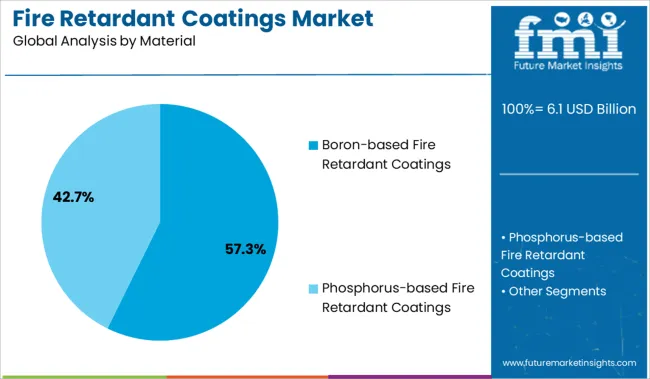
The boron-based fire retardant coatings segment is expected to contribute 57.3% of the market revenue in 2025, establishing itself as the dominant material category. Boron compounds are highly effective in fire retardancy due to their ability to form a protective glassy layer when exposed to heat, reducing flammability and smoke production.
These coatings are prized for their thermal stability, low toxicity, and resistance to weathering, making them suitable for automotive and industrial applications. The segment’s growth has been supported by advancements in boron-based formulations that enhance adhesion and durability.
Additionally, boron’s eco-friendly profile aligns with increasing environmental regulations and sustainability goals. As industries seek materials that combine performance with safety and environmental compliance, the boron-based coatings segment is expected to sustain its market leadership.
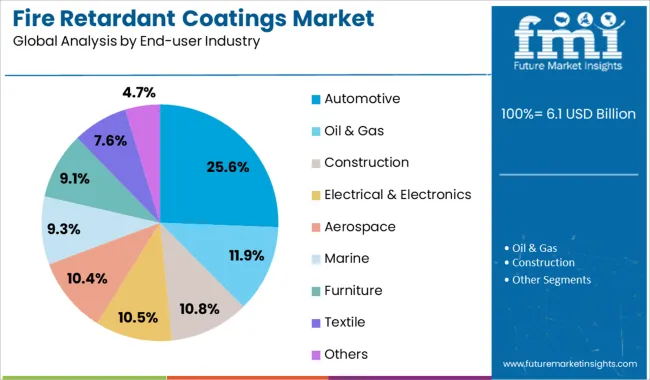
The automotive industry segment is projected to represent 25.6% of the fire retardant coatings market revenue in 2025, maintaining its position as a significant end-user. This sector has seen growing adoption of fire retardant coatings due to stricter safety regulations and the need to protect vehicle components from fire hazards.
Fire safety in automotive manufacturing extends beyond engine compartments to include interior materials, wiring, and fuel systems. The increasing production of electric vehicles, which involve high-voltage battery systems, has further emphasized the importance of effective fire retardant coatings.
Automakers are investing in coatings that provide enhanced protection without adding weight or compromising vehicle design. As the automotive sector continues to innovate and prioritize passenger safety, the demand for fire retardant coatings in this industry is expected to grow steadily.
Due to the rising infrastructure of the industrial and commercial sectors, as well as connected electric supply and processes, such as fire places, where the risk of an accident is higher, the demand for fire retardant coatings has increased in recent years.
From the previous several years, the equipment utilized in manufacturing facilities such as the automobile, construction, and oil and gas industries has been prone to fire. In addition to statutory HSE (health, safety, and environmental management) standards, the sales of fire retardant coatings is quickly increasing across a wide range of end-use industries, allowing end users to profit from insurance claims in the case of a severe fire.
In addition, the demand for fire retardant coatings is becoming increasingly apparent in electronic and electrical items, whose internal circuitry is exposed to a high rate of heat. As a result, fire retardant coatings market outlook shows the profitable growth during a forecast period.
Fire retardant coatings market expands under the impact of heat to form a multicellular charred layer that works as an insulating barrier. Furthermore, the global fire retardant coatings market share is likely to be hampered by high inflation in raw material prices for fire retardant coatings.
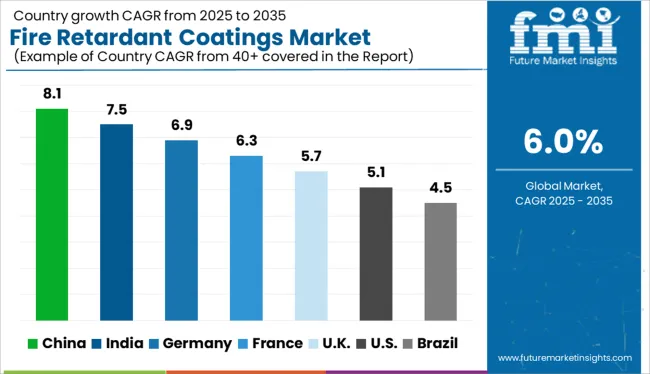
The global fire retardant coatings market can be divided into seven distinct regions. In developed economies, rapid industrialization and modernization will continue to drive the sales of fire retardant coatings expansion.
Due to rising industrial infrastructure and concern for safeguarding property and safeguards throughout the globe, areas such as Asia Pacific, Latin America, and MEA are expected to drive demand for fire retardant coatings during the projected period.
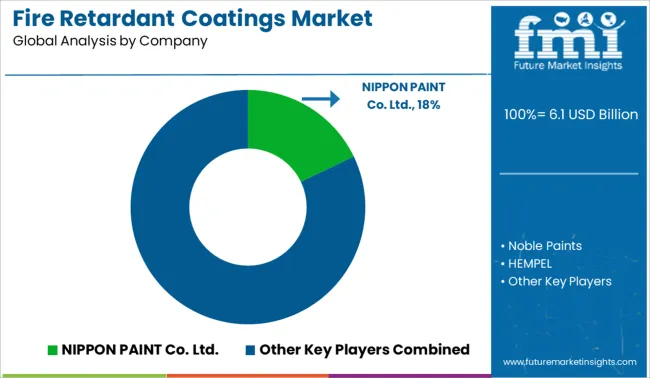
Few global fire retardant coatings market key players are NIPPON PAINT Co. Ltd.S, Noble Paints, Akzo Nobel, PPG Industries, HEMPEL, Carboline, Kansai Paints, Jotun, Promat International, Nullifire, GCC Applied Technologies, and Isolatek International.
These players are employing various strategies, such as mergers & acquisitions, partnerships, collaborations, etc., in order to consolidate their market position and augment the sales of fire retardant coatings.
| Report Attribute | Details |
|---|---|
| Growth Rate | CAGR of 6% from 2025 to 2035 |
| Base Year for Estimation | 2024 |
| Historical Data | 2014 to 2024 |
| Forecast Period | 2025 to 2035 |
| Quantitative Units | Revenue in USD Billion, Volume in Kilotons and CAGR from 2025 to 2035 |
| Report Coverage | Revenue Forecast, Volume Forecast, Company Ranking, Competitive Landscape, Growth Factors, Trends and Pricing Analysis |
| Segments Covered | Application, Product Type, Material, End Use Industry, Region |
| Regions Covered | North America; Latin America; Europe; South Asia; East Asia; Oceania; Middle East and Africa |
| Key Countries Profiled | USA, Canada, Brazil, Argentina, Germany, UK, France, Spain, Italy, Nordics, BENELUX, Australia & New Zealand, China, India, ASEAN, GCC, South Africa |
| Key Companies Profiled | NIPPON PAINT Co. Ltd.; Noble Paints, Akzo Nobel; PPG Industries; HEMPEL, Carboline; Kansai Paints; Jotun.; Promat International; Nullifire; GCC Applied Technologies; Isolatek International. |
The global fire retardant coatings market is estimated to be valued at USD 6.1 billion in 2025.
The market size for the fire retardant coatings market is projected to reach USD 10.9 billion by 2035.
The fire retardant coatings market is expected to grow at a 6.0% CAGR between 2025 and 2035.
The key product types in fire retardant coatings market are non-intumescent fire retardant coatings and intumescent fire coatings.
In terms of material, boron-based fire retardant coatings segment to command 57.3% share in the fire retardant coatings market in 2025.






Full Research Suite comprises of:
Market outlook & trends analysis
Interviews & case studies
Strategic recommendations
Vendor profiles & capabilities analysis
5-year forecasts
8 regions and 60+ country-level data splits
Market segment data splits
12 months of continuous data updates
DELIVERED AS:
PDF EXCEL ONLINE
Firefighter Tapes Market Size and Share Forecast Outlook 2025 to 2035
Fire Pump Test Meter Market Size and Share Forecast Outlook 2025 to 2035
Fire Sprinkler System Market Size and Share Forecast Outlook 2025 to 2035
Fire Protection Materials Market Size and Share Forecast Outlook 2025 to 2035
Fire Extinguisher Market Size and Share Forecast Outlook 2025 to 2035
Fire Stopping Material Market Size and Share Forecast Outlook 2025 to 2035
Fireproof Insulation Market Size and Share Forecast Outlook 2025 to 2035
Fire Tube Chemical Boiler Market Size and Share Forecast Outlook 2025 to 2035
Firefighting Foam Market Size and Share Forecast Outlook 2025 to 2035
Fire Resistant Cable Market Size and Share Forecast Outlook 2025 to 2035
Fire Suppression System Market Size and Share Forecast Outlook 2025 to 2035
Fire Protection System Pipes Market Size and Share Forecast Outlook 2025 to 2035
Fire Stopping Materials Market Size and Share Forecast Outlook 2025 to 2035
Firefighting Drone Market Size and Share Forecast Outlook 2025 to 2035
Fire Resistant Fabrics Market Size and Share Forecast Outlook 2025 to 2035
Fire Door Market Size and Share Forecast Outlook 2025 to 2035
Fireclay Tiles Market Size and Share Forecast Outlook 2025 to 2035
Firearms Market Size and Share Forecast Outlook 2025 to 2035
Fire-resistant Paint Market Size and Share Forecast Outlook 2025 to 2035
Fire Collar Market Size and Share Forecast Outlook 2025 to 2035

Thank you!
You will receive an email from our Business Development Manager. Please be sure to check your SPAM/JUNK folder too.
Chat With
MaRIA